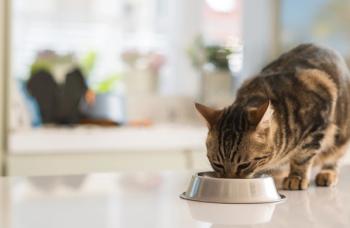
Ringworm–diagnostics, treatment, and management strategies (Proceedings)
Ringworm is rarely life threatening in household pets, but in the shelter, it can lead to almost unmanageable outbreaks, excessive costs, and euthanasia due to its zoonotic potential.
Ringworm is rarely life threatening in household pets, but in the shelter, it can lead to almost unmanageable outbreaks, excessive costs, and euthanasia due to its zoonotic potential.
What is different about managing ringworm in a population?
• Screening is a big deal – a missed lesion can be very, very costly
• Treatment has to be effective – it must work fast and protect the environment
• Confirmation of cure is critical – a missed fungus can be very, very costly
• Decontamination must be successful – future exposure of naïve cats is inevitable
Who are the players?
• Microsporum canis
• Trichophyton mentagrophytes
• M. gyspeum
Microsporum canis is by far the greatest concern in a shelter environment. Trichophyton mentagrophytes and M. gyspeum are less readily spread animal to animal, and do not have as great a zoonotic potential. Skill and success in diagnosis and treatment of M. canis is most important in order to protect feline and canine populations and the people who are exposed to them.
What can ringworm infection look like?
Ringworm cannot be diagnosed by clinical appearance alone. The classic presentation is a circular area of hair loss and scaling. The most common locations include the face, pinnae, feet and tail. However, ringworm can present with a wide range of appearances, including military dermatitis or large areas of hair loss with or without crusts and exudate. Ringworm can infect the toe nails and nail beds. Ringworm may either resemble or secondarily infect conditions such as "stud tail", "chin acne", indolent lip ulcers and eosinophilic plaques. Lesions may or may not be pruritic. Any skin lesion in a high risk cat should be examined with a Wood's lamp, followed by a fungal culture in order to definitely rule ringworm in or out.
Wood's lamp
Although not a perfect diagnostic test due to the relatively high frequency of false negative results, a Wood's lamp - correctly used - can be a helpful and cost effective screening tool. A negative Wood's lamp exam does not, of course, rule out infection and suspicious lesions should always be cultured. Some drugs and other products, notably tetracycline drugs and ointments, will also fluoresce. Fluorescence induced by dermatophyte infection can be distinguished as it will not easily be rinsed off. Observation of known lesions will help develop proficiency in recognizing true fluorescence. In order to maximize the usefulness of this test, it is important to use the right equipment, correctly:
• A true Wood's lamp should be used, as opposed to a generic UV light. Woods lamps fluoresce at a particular wave length (360 nm).
• A plug-in, rather than battery model, is ideal as the stronger light is more likely to generate fluorescence.
• Perform the exam in a completely dark room.
• Allow the light to warm up for 5-10 minutes, and hold the lamp over the suspect areas for at least 5 minutes, as some strains take time to fluoresce.
Fungal culture
The only truly reliable way to diagnose ringworm is via fungal culture:
• Wipe cat with damp cloth to remove coat contaminants.
• Use a fresh toothbrush in its package.
o Toothbrush culture always for exposed cats with no visible lesions.
o Toothbrush culture can also be used to collect samples from suspicious lesions. Alternately, if no clean toothbrush is available, hemostats or forceps may be used to pluck a sufficient quantity of hair from the suspect areas.
• At least 30 strokes:
o Especially face, inside pinnae, around nail beds, lesions
• Swiffer™ for environment.
o Cut into small sections, wipe possibly contaminated surfaces until visibly dirty
• Individual labeled baggies if multiple samples.
• Avoid heat exposure during transport (leaving samples in a hot car for twenty minutes could be enough to kill spores and lead to a false negative culture result).
Fungal culture details
• Room temperature dermatophyte test medium (the stuff that turns red with growth of most pathogenic dermatophytes); combo plates with Saboraud's agar or Rapid Sporulating Media are available and may assist with microscopic identification.
o Plate style culture media is preferred over jars (decreased likelihood of contaminants, easier to take a tape sample for microscopic exam).
o There is no such thing as a culture media that gives reliable results in less than ten days.
• Press toothbrush firmly into the culture, but not so much that culture is disrupted
o Press Swiffer™ firmly numerous times
• Incubate at 75°- 85° F in the dark with a humidity source (A lightbulb can be used to create a makeshift incubator. Place a tray of water in the incubator to maintain humidity.)
• Examine daily until growth or for 21 days
o Most M. canis will grow within 10 days in untreated cats – tentative negative at that point. Trichophyton tends to take longer to grow, but is not as great an infectious threat. Growth often takes longer once a cat is on treatment.
Identification
Not all dermatophytes turn the dermatophyte test medium red, so false negatives are possible. Some other types of non-pathogenic fungi can cause the red color, so false positives are possible too. To be certain of a diagnosis of ringworm, it is imperative to microscopically examine and positively identify the fungus. This is accomplished by microscopic examination of a "tape prep":
1. Place a drop of lactophenol blue stain on a slide
2. Dab the sticky side of a piece of tape on the suspect colony
3. Place the tape over the drop of stain and examine under the microscope
Most culture media kits come with a guide to microscopic identification. Descriptions and photos for fungal identification can be found in Muller and Kirk's Small Animal Dermatology, 6th Edition, page 122 (Saunders).
Treatment of ringworm infection in multiple cat populations
In a population, treatment failure is more evident and common, and the requirements for highly effective treatment are rigorous. The most important component of treatment in a population is topical therapy. This is critical in order to reduce immediate and ongoing environmental contamination. Of all available topical therapies, lime sulfur dip is cost effective, relatively easy to apply rapidly to a number of cats, and has been documented to work in a shelter setting. Chlorhexidine shampoos and locally applied topical ointments are not effective. At the point these lecture notes are being written, Accelerated Hydrogen Peroxide has not been tested clinically so recommendations cannot yet be made on using this product.
Lime sulfur details:
• Use 8% concentration
• Apply twice weekly throughout treatment
• Okay in pregnant and nursing cats, kittens > 2-3 weeks old
o Wipe nursing moms, keep kittens warm
• E-collar afterward may not be necessary
Lime sulfur application
• Do not pre-wet
• Consider using a pesticide sprayer for application:
o Add powder first, then water
o Keep close to cat
• Sponge dip on face, nose and ears
Systemic treatment
Systemic treatment is an important adjunct to topical therapy, especially in a shelter where time-to-cure is an important consideration. Itraconazole (5-10 mgs/kg PO SID) is a good choice due to its demonstrated efficacy, relative safety, and long half-life in the skin. Fluconazole (10 mgs/kg PO SID) is also reportedly effective. Lufenuron (Program™) has been shown in repeated studies to be ineffective. These drugs should be avoided in pregnant animals. Compounding may be necessary to allow administration of sufficiently small doses for kittens. Alternatively, capsules can be divided manually into smaller doses, using gel caps, meatballs or butter.
Verifying cure
With effective topical and systemic treatment, fungal cure may occur prior to clinical cure. Conversely, un-treated or ineffectively treated cats may appear cured several weeks prior to fungal cure – that is, they look all better, but are still contagious to people and other animals. For this reason, it is crucial to verify cure by consecutive negative fungal cultures. Three consecutive negative cultures, one week apart, are generally recommended. Fungal cultures should be initiated staring at week one of treatment
What kills ringworm?
The short answer is, not much that is safe to use around people and cats! Options include:
• Bleach diluted at 1:10 (1.5 cups per gallon)
o Applied to a clean surface
o At least two applications, allowing the surface to dry between applications
• Studies are currently being conducted to determine the efficacy of accelerated hydrogren peroxide on ringworm.
• High heat (> 110° F)
o Commercial steam cleaner
o Commercial dish washer
o Dryer
o Hot car
• Dry environment and sunlight helps
What doesn't kill ringworm?
Equally important to know, many of the products commonly used in veterinary clinics and shelters – and even some labeled as effective against ringworm – have been shown NOT to work in independent trials. Ineffective or unreliable products include:
• Chlorhexidine
• Quaternary ammonium compounds
• Potassium peroxymonosulfate (Trifectant™, Virkon-S™)
• Povidone-iodine
• Time: ringworm can persist for months and years if not mechanically removed or killed with an effective disinfectant, especially in a dark, moist environment.
Acknowledgements:
Thanks to the Shelter Medicine Dermatology Project (a partnership between the Dane County Humane Society and the University of Wisconsin - School of Veterinary Medicine Dermatology Research Laboratory) for much of the information included in this talk.
Newsletter
From exam room tips to practice management insights, get trusted veterinary news delivered straight to your inbox—subscribe to dvm360.





